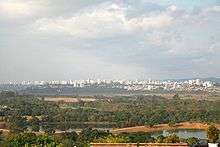Latvian Brazilians
|
Latvian immigrants in Brazil | |
| Total population | |
|---|---|
| (25,000 Latvian Brazilians[1][2]) | |
| Regions with significant populations | |
| Mainly Southern and Southeastern Brazil | |
| Languages | |
| Predominantly Portuguese | |
| Religion | |
| Christianity (mainly Lutheranism and Roman Catholicism), and others | |
| Related ethnic groups | |
|
Other Brazilian, White Latin American and Latvian people other White Brazilian as Finnish, Scandinavian, German, Polish, Lithuanian, Ukrainian and Russian Brazilians |
Latvian Brazilians (Portuguese: Letono-brasileiros, Letões brasileiros) are Brazilian citizens of full, partial, or predominantly Latvian ancestry, and Latvian-born people residing in Brazil.
Brazilians of Latvian origin amount to around 25 thousand, being the largest Latvian community of South America.[3][2]
History
The Latvian immigration in Brazil began in 1890, when the first 25 families departed from Riga and arrived in Laguna (State of Santa Catarina). It is estimated that more than 3 thousand Latvians, from Latvia and Latvian communities in Russia, emigrated to Southern Brazil in search of better socio-economic conditions and freedom of worship. An agency for emigration to Brazil was founded in Riga.
Colonization
In the State of Santa Catarina the Latvian settlers established themselves in the following localities (year): Rio Novo (1890), Rio Oratório (1892), Rio Mãe Luzia and Massaranduba (1893), Jacu-Açú (1898), Ponta Comprida (1899), Terra de Zitnmerman (1900), Schroederstrasse and Linha Telegráfica (1901).
In the State of Rio Grande do Sul in Ijuí (1893).
Then followed Latvian colonies in the state of São Paulo: Nova Odessa, Jorge Tibiriçá or Corumbataí (1906), Nova Europa (1907), Paríquera-Açú (1910), São José dos Campos (1914) and Varpa (1922).
Culture
The preservation of the cultures of the Baltic peoples outside their Baltic homeland has been a primary focus of interest and concern for Lithuanians, Latvians and Estonians alike, especially since the diverse migratory travails of large segments of their populations over the course of the last century. Essentially, the dispersal and resettlement of so many Baltic people all over the world has forced them to redefine their identity. As minority communities transplanted into host societies quite different in character and geographically remote from their native region, their history has characteristically been one of adjustment and adaptation to new political, socio-economic and cultural, not to mention ecological, environments.
Because a great variety of collective motivations brought about under distinct and historically separate circumstances have stimulated mass immigration from the Baltic, one can expect a corresponding variety in the settlement patterns and social organization of these groups in their new settings, especially when observed at different points in the procession and development of subsequent generations.
Work

Vārpa is a Latvian Baptist colony in the southern Brazilian State of São Paulo, located on the relatively isolated "Coffee Frontier," 700 kilometers inland from the Port of Santos. Only occasional patches of dense tree growth on a hilly landscape hint that there was once a virgin forest that was cleared to make way for agriculture and human settlement. Today only a few hundred Latvian families remain in Vārpa. At its peak during the 1930s and 40's, virtually all of Vārpa's population, which numbered almost 2,000 people,[4] was Latvian. Most of the croplands surrounding the colony have been gradually turned over to native Brazilian cattle ranchers. The dairy, sawmills and dams which once marked Vārpa's prosperity have been in ruins for decades. Even a once neatly kept memorial at Vārpa's Pioneer Cemetery is overgrown with weeds and almost impossible to reach.
Though many aspects of daily life were meticulously documented by some Latvians in Vārpa, only two comprehensive histories of the colony exist, and these are in Portuguese. This accounts for Vārpa's virtual exclusion from the body of scholarship on Baltic immigration. The information in this article is based on a synthesis of documentary remains and oral history collected during February 1986 as part of an independent research project.
For a personal account of the 1922 Baptist migration and founding of Varpa Colony in Brazil, log onto Tarzier.org. For the spiritual foundations of the migration, check out Spirit Speaks, on the same site.
The migratory wave which led to the founding of Vārpa had a very different origin and spirit than other movements of Latvians from their homeland. Like some stereotypes of the "classic" European immigrant, Latvian Baptists were pioneers who looked to the vast and undeveloped frontier of the Brazilian interior with great hopes for opportunity, self-sufficiency, and a free and harmonious existence. They held high hopes for a utopian existence in the new country. Like refugees from famine or war, Latvian Baptists were also under great pressure to "escape" to a safe place, far from the difficult conditions that threatened their well-being at home. Unlike the refugees and opportunity seekers, however, the Baptists who settled Vārpa left Latvia just as the turmoil of World War I, the struggles for an independent republic, the hopelessness of material privation and the indiscriminate destruction of land and property had finally come to an end.
See also
References
- ↑ Revista Época Edição 214 24 June 2002
- 1 2 "Um atalho para a Europa". Epoca. Editora Globo S.A. 24 June 2002. Archived from the original on 21 August 2012.
- ↑ Brazilian Embassy in Stockholm
- ↑ A Millenarian Migration: Varpa